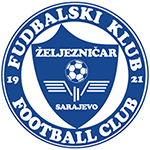After the club’s greatest international success, Ivica Osim led the team for another season. They again won seventh place in the 1985/1986 season, after which Osim was appointed as the coach of the Yugoslav national team. Several first-team players left the club during that time, either moving abroad or to other domestic clubs. Given these circumstances, a breakthrough in results was impossible, but thanks to the foundation previously laid, the club achieved results that were sufficient for the middle of the table for a few more seasons.
At the transition from the 1980s to the 1990s, hard times returned for the club. In the 1988/1989 and 1990/1991 seasons, Željezničar secured sixteenth place, which was the last position that ensured survival in the First Federal League. Truth be told, the season in between (1989/1990) was played a bit better, and a solid seventh place was secured. However, despite being led by Miša Smajlović, the departure of a large number of players could not be easily replaced. Additionally, the construction of the northern stand of the Grbavica stadium had drained the club’s resources.
The change of generations was inevitable, but it could not be successfully carried out overnight. Some new kids grew up in the youth categories, and many of them will make enviable careers in the future. Players such as Suvad Katana, Gordan Vidović, Rade Bogdanović, Mario Stanić, Elvir Baljić, Haris Alihodžić, Sead Kapetanović, Sead Halilagić, and Veldin Karić do not even need a special introduction. All of them later played for respectable European clubs, and most of them acquired the status of national team members. However, at the time, it was a fairly young team, the youngest in the First Federal League. Therefore, it should not be surprising that the 1991/1992 season was extremely turbulent, unfortunately, not only in the sporting sense.
The breath of war could be sensed in the air. Croatia and Slovenia had already declared their independence, and clubs from those republics, now new independent states, had started playing in their newly established competitions. The Yugoslav First Federal League was now composed of clubs from the remaining four republics, with five clubs from Bosnia and Herzegovina. Željezničar played the autumn part of the season in a variable manner, and it was obvious that any serious bad results in the spring could mean a fight for survival in the league. In the spring, exactly that happened. Several consecutive defeats and then a strike from the first team led the team to a difficult situation without any obvious solutions. During the strike, a couple of games were played by the juniors. Despite all of that, advancing to the semi-finals of the cup improved the bad season. However, in the end, everything was “spiced” by the start of war activities in Sarajevo. Aggression in some parts of Bosnia and Herzegovina had started earlier, but Sarajevo was relatively peaceful. Despite the declaration of independence of Bosnia and Herzegovina, our clubs planned to play that season to the very end. However, on April 5, everything was definitively interrupted. On that day, among all other matches, the match between Željezničar and Rad from Belgrade was planned to be played at Grbavica. The events of that day are known to all of us. The game was never played, and thus Željezničar ended its run in Yugoslav competitions. In addition, that meant that all normal sports activities ended until further notice. The war came, and sport in Sarajevo, as well as in the whole of Bosnia and Herzegovina, was left for better times.









